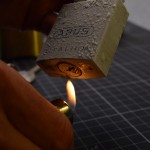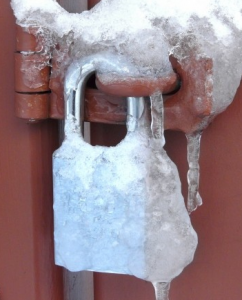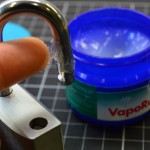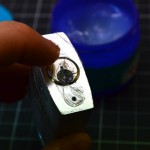Every year we get a number of enquiries asking for advice on dealing with this so here are a few hints and tips. Padlocks and the cold don’t go terribly well together. All padlocks, especially combination locks, use complex mechanisms with springs, pins and bars. These all expand and contract with a change in temperature and worse, will get stuck if only a little bit if water gets in and freezes.
If you would like to see the results of our tests then please see the Testing and Results section.
1. Choose A More Resilient Lock
The first thing to consider are locks that are more resilient to freezing. Generally the higher security locks will use a ball bearing locking system, rather than spring loaded bars. This basically means they unlock using less moving parts and be less likely to freeze together. In the same way, combination padlocks are much more likely to freeze and be difficult to open than keyed padlocks.
Then consider padlocks that use plastic cases. These are mostly designed to keep the rain off the lock but it also prevents excess water ingress into the mechanism which can then freeze overnight. On the right is an example of a keyed lock that uses both a ball bearing mechanism and has a plastic covering.
2. Prevent Your Lock Freezing
There are a few things you can do to help prevent you your padlocks from freezing in the first place but the number 1 piece of advice we can give is to prevent or stop water from getting into the lock! Keep the padlock dry and you’ll be fine.
Most lubricants have a freezing temperature well below water and below what you will encounter in the UK. In our test it did help to spray the lock first but only a little so don’t rely on this method entirely.
The best type are those which will stay inside the lock and not just drip out. The PS88 spray we have is very god but you can also try various other oils and WD40, although this doesn’t tend to last very long.
One of the best methods is to simply put the lock in a sock or, in our example in the photo, a cheap glasses case. These are especially good since they don’t soak up much water and have a draw string.
Take the sock or glasses pouch and put it over the top each time you leave the lock. In some places, especially town centres this might not be possible but in the countryside this is a very effective method. It prevents condensation from forming on the locks and then running down into the mechanism and also keeps the rain off.
Grease or Vaseline
This works very well and much better than lubrication but it is messy. Often freezing occurs when water, dew or condensation gets into the lock. You can put Vaseline, grease, or in our case, we used Vapour Rub as that’s what we had to hand. Apply it around the base of the shackles where they enter the padlock body to ensure no water can drip down inside. Also put it on the keyway, especially if the lock is not orientated downwards. Ensure the lock is 100% dry when you do this, otherwise you’ll just be trapping in existing water.
3. Dealing With A Frozen Lock
We don’t mean to be pessimistic but if the lock does freeze then its very difficult to get it open quickly. Traditional car anti-freeze does work but it takes a while. As you apply it then shake and tap the lock the try and free the mechanism inside. Hot water will work very well but rarely will you have that as an option. Pour the water on slowly rather than all at once and if you can, fully immerse the lock in warm water. If you have no warm water or antifreeze then you’re simply going to have to get your hands cold. Put a cloth or handkerchief over the lock and hold it until it thaws out. It will take approx 5-15 mins depending on how much water got in there to freeze.
 Lastly if you have a lighter to hand, then you can carefully try to heat the lock that way. We can’t officially advise this obviously but if you do try it then start under the keyway as that is often the first place to freeze. Keep the lighter perfectly upright to ensure the heat travels right up into the keyway.
Lastly if you have a lighter to hand, then you can carefully try to heat the lock that way. We can’t officially advise this obviously but if you do try it then start under the keyway as that is often the first place to freeze. Keep the lighter perfectly upright to ensure the heat travels right up into the keyway.
Once that is thawed out and you can get the key in then, you should be able to get it open with a little persuasion. DO NOT use this method in conjunction with DeIcer or lubricant if it is flammable!!!!






